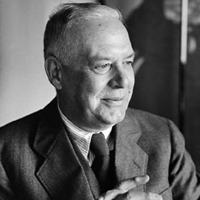The Emperor of Ice-Cream by Wallace Stevens: Summary and Critical Analysis
The Emperor of Ice-Cream is the most popular poem of Wallace Stevens. Stevens 'plots' this story into two equal stanzas: one for the kitchen where the ice cream is being made, and another for the bedroom where the corpse awaits decent covering. He "plots" it further by structuring the poem as a series of commands from an unknown master of ceremonies, directing, in a diction of extreme oddness, the neighbors in their funeral duties.

Wallace Stevens (1879-1955)
Both the symbolic kitchen stanza and the symbolic bedroom stanza end with the same third-order refrain echoed by the title. "The only emperor is the emperor of ice-cream." The title, in simple words, means something like this: since life is like ice-cream, the ruling standard of life and its reality is the emperor of that fact itself; therefore, enjoy life as you'd enjoy ice-cream itself.
The title reflects that human beings are no more resistant to death than ice cream is to the sun. The poet speaks in the voice of a man (the poet's spokesman), addressing the neighbors to carry out the funeral in certain ways. It is common in some communities to satisfy the dead in this way, with food and drink, after a time of mourning. This is common in tribal communities; and it is suggested that Stevens has based the poem on his experience of Canadian tribes, or maybe on some Red Indian American tribe.
The poem begins with the neighbor's confident command to the other people; he is giving instructions as to how to conduct the funeral (waking). In the first stanza, the man calls for a person muscular enough to whip up desserts by hand; perhaps there is not enough money for an expensive mixer. People must eat and drink when they arrive the poor woman's house to attend her 'wake' and funeral. This implies that we need not grieve and fast and torture the living when one who has died. The desserts will have to be served in kitchen cups; there is no fine china or crystal. The common people who will attend will come in their everyday clothes, rather than formal attire; the flowers will be brought in last month's newspapers, rather than in vases, or as garlands. All these details suggest that there is nothing fanciful, nothing romantic, or nothing special about death and its aftermath; indeed, death is too ordinary and natural to be shocking. Stevens avoids the euphemisms and denials that often accompany the details and descriptions of death. From the second stanza, the poem continues with the preparations. The man asks someone to take a sheet from the top of a broker dresser to cover the dead woman's face; even if that means that her ugly feet will protrude from the too short covering. Instead of lighting soft and dim candles, the bright light should be turned to glare on her body, to show that she is now cold and silent in death. Stevens is insisting that one must look directly at death, in all its mater-of- factness, and see it not as a state of some mystical or spiritual transformation, but rather as actual fact to be faced and dealt with. To romanticize death is to invite more grief than less. The wake (ceremony) takes place in the woman's own house, rather than in a church; and the preparation are inexpensive and minimal, including making the food in her own kitchen; this reflects Stevens's insistence that death should not be romanticized, idealized, or sentimentalized. Perhaps if death will inevitably melt everyone away to nothing, no matter how tasty or delicious they may be while alive, in terms of the ice-cream metaphor. So, in the classic tradition of carpe diem, one should seize the day while one is able to do so.
The central image in "The Emperor or Ice-Cream" is complex, ambiguous and ambivalent. The emperor of ice-cream is further specified as the only "emperor". Death is, as everyone present can see, the end of life, a natural and inevitable thing. The poem ends by repeating this statement: "the only emperor is the emperor of ice- cream"; with the title and the two refrains, the enigmatic-looking statement is repeated three times, for emphasis, in the poem. These are two possible interpretations of the ice cream: one that the emperor is life, the other that he is dead. Ice cream is tasty, transitory, and cold: life may be tasty and perishable, but is not cold. The quality of coldness may suit death, for it is cold but scarcely transitory, unless we assume than Stevens believes in an afterlife, which he doesn't. This mixture and complication of the implications in the meaning of the image of ice-cream seems to suggest that life and death are inextricable bound and blended together. Whoever the emperor is, he is more real than the run-of-the-mill emperors. Ice cream is both death and life.
Cite this Page!
Sharma, K.N. "The Emperor of Ice-Cream by Wallace Stevens: Summary and Critical Analysis." BachelorandMaster, 14 Nov. 2013, bachelorandmaster.com/britishandamericanpoetry/the-emperor-of-ice-cream.html.
